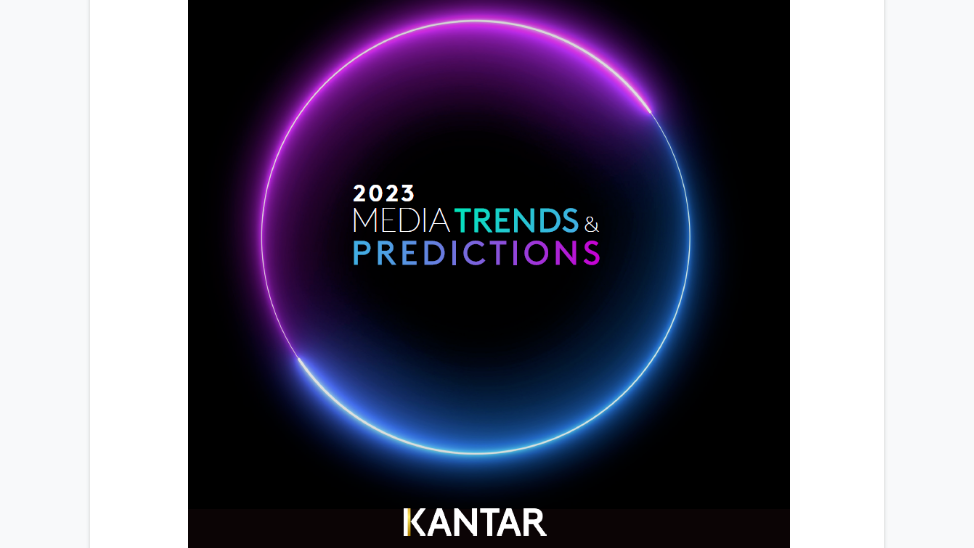Kantar Predicts a Challenging 2023 for Media, Advertisers
Media firms are dealing with inflation, consumer choice

With the media environment changing and economic conditions becoming more difficult, Kantar has looked ahead and made predictions to help media companies and advertisers navigate 2023.
The big trends involve the evolution of VOD to have a broadcast-like appointment viewing quality, ad supported streaming helping viewers offset inflation, and the need for advertisers to contextualize campaigns to put the most effective ads in front of targeted consumers.

“We foresee a year full of challenge and opportunity for the media industry. As global price rises impact consumer spend and advertising, campaign planning could be optimized through improved data application, making budgets go further. From post-cookie solutions to better campaign planning, data is our fuel - but its usage is changing,” said John McCarthy, strategic content director for Kantar’s media division. “The future will continue to deliver a host of new technologies, each brimming with potential, and it’s important not to get lost in the hype.”
Kantar’s predictions and prescriptions include:
VOD embraces appointment TV strategies – Marking a new chapter for the TV and video market, the winners in the platform wars will deploy hybrid strategies balancing VOD (video on demand) and linear content. Broadcasters are adopting aspects of VOD strategy that fit their positioning while preserving their points of difference, and VOD platforms are adopting concepts like ‘appointment TV’ and curated content discovery. The market will shift away from all-at-once release strategies and box-set bingeing for new content in order to maximize revenues.
Ad-supported models answer to inflation worries – U.S, data shows that market penetration for ad-based video-on-demand (AVOD) grew from 20% in Q2 21 to 23% by Q2 22. Kantar’s Media Reactions 2022 study shows consumers are more accepting of advertising, and as rising costs are making ad-funded content more palatable. The timing is right to introduce ad-funded tiers to limit price-sensitive churn. However, ad-models risk creating two types of viewers: those with less disposable income who become over-targeted by ads, and those with more disposable income, who are more attractive to advertisers, but are harder to reach.
Contextualize or fail – Marketers must prepare for a post-cookie landscape by experimenting with proxy-based targeting systems and contextual advertising. Targeting within closed ecosystems, in which consented first-party data is available, will still be possible, but wider cross-platform targeting has hit the barrier of consumer privacy. There will be incremental improvement in the coming years, but the hyper-targeted ecosystem the internet once promised looks increasingly unviable and initial assumptions about the granularity of targeting outside closed ecosystems may have to be reappraised.
The smarter way to stay on top of broadcasting and cable industry. Sign up below
Dynamic product placement edges closer – Nearly 75% of all US broadcast network shows have some form of product placement, targeting those viewers difficult to reach through conventional advertising forms according to Kantar’s Future Viewing Experience 2022 report. Dynamic product placement – enabling a product, billboard or screen featured in content to be substituted or overlaid with a different brand or advert – is also growing. Like addressable advertising, different viewers could – with the right data – be shown tailored ads. However, technological possibilities will need to be balanced against what’s acceptable to audiences. A negative impact may be inadvertently achieved if a placement is clearly anachronistic, jarring or out of place. Thus, tailored content should be closely monitored.
Media companies need to respond to advertisers’ (and consumers’) Net Zero ambitions – Reducing the carbon impact of media and advertising to net zero is the business challenge of our time and a greater opportunity. 2023 needs to be a year of sustainable innovation – whether that’s brands offering green products and services, media owners offering more energy-efficient services, or agencies rethinking how their planning, buying and production strategies are impacting the climate. For example, Media Figaro has launched a partnership with French start-up Vidmizer to reduce the weight of video campaigns in a bid to use less energy. With up to 80% reductions in carbon reported, it’s a good example of how technological partnerships can reduce energy expenditure. ■
Jon has been business editor of Broadcasting+Cable since 2010. He focuses on revenue-generating activities, including advertising and distribution, as well as executive intrigue and merger and acquisition activity. Just about any story is fair game, if a dollar sign can make its way into the article. Before B+C, Jon covered the industry for TVWeek, Cable World, Electronic Media, Advertising Age and The New York Post. A native New Yorker, Jon is hiding in plain sight in the suburbs of Chicago.

